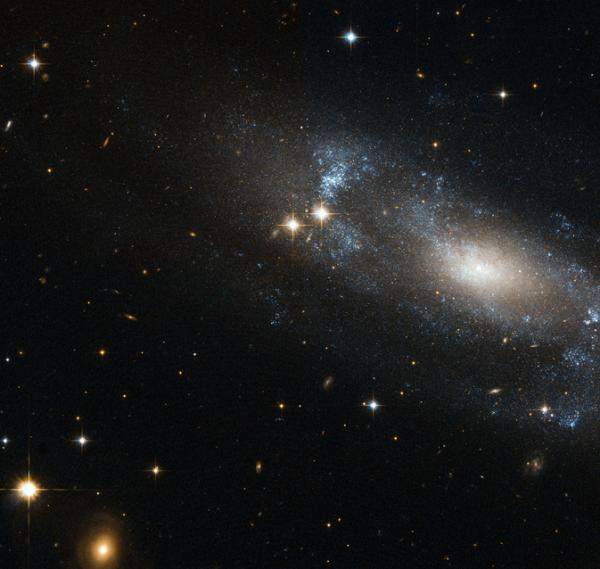NASA’s Hubble Space Telescope has captured an image of the spiral galaxy ESO 499-G37, seen below against a backdrop of distant galaxies, scattered with nearby stars.
The galaxy is viewed from an angle, allowing Hubble to depict its spiral nature. The faint, loose spiral arms can be distinguished as bluish features swirling around the galaxy’s nucleus.

This blue tinge emanates from the hot, young stars located in the spiral arms. The arms of a spiral galaxy have large amounts of gas and dust, and are typically considred stellar nurseries where new stars are constantly forming.
The galaxy’s most characteristic feature is a bright elongated nucleus. The bulging central core usually contains the highest density of stars in the galaxy, where a large group of comparatively cool old stars are typically packed in this compact, spheroidal region.
One feature common to many spiral galaxies is the presence of a bar running across the center of the galaxy, which are believed to act as a mechanism that channels gas from the spiral arms to the center, thereby enhancing star formation.
Recent studies suggest that ESO 499-G37’s nucleus sits within a small bar up to a few hundreds of light-years along, about a tenth the size of a typical galactic bar.
Astronomers hypothesize that such small bars could be important in the formation of galactic bulges since they might provide a mechanism for bringing material from the outer regions down to the inner ones. However, the connection between bars and bulge formation remains unclear since bars are not a universal feature in spiral galaxies.
The galaxy ESO 499-G37 lies in the southern border of the constellation of Hydra, which is shared with Antlia.
ESO 499-G37 was first observed in the late seventies within the ESO/Uppsala Survey of the ESO (B) atlas. This was a joint project undertaken by the European Southern Observatory (ESO) and the Uppsala Observatory, which used the ESO 1-metre Schmidt telescope at La Silla Observatory, Chile, to map a large portion of the southern sky searching for stars, galaxies, clusters and planetary nebulae.






